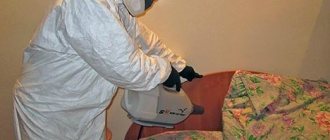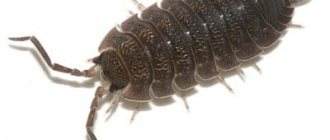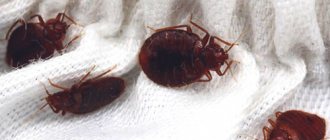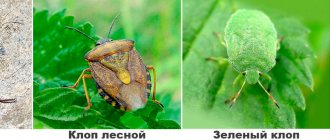How do you know if there are bedbugs in your house?
The appearance of annoying bloodsuckers in an apartment, private house or country house is signaled by indirect symptoms and direct evidence. The main signs of contamination of a room include:
- the appearance of bites on the human body;
- unpleasant aroma in the house;
- obvious finds - waste products;
- traces of blood on the bed.
Bedbug bites. The first symptom of an ectoparasite invasion is the regular appearance of wounds. Bedbug bites are sometimes difficult to distinguish from attacks of other insects. However, there are a number of features that are characteristic exclusively of arthropod bloodsuckers.
How do bedbugs bite?
- Painless attack. During the bite, the adult injects an anesthetic substance into the body. The person feels discomfort the very next morning - the wound turns pink, swells, and itching begins.
- Multiple punctures. The entire population of ectoparasites, regardless of gender and age, are absolute bloodsuckers - they cannot exist without blood, and therefore without humans. The entire bug family takes turns hunting. The bug needs feeding every 6-10 days, nymphs feed more often.
- Footprints in the form of a path. An adult bloodsucker does not get enough of it with one bite; it takes several steps and pierces the skin again. The larva does not require much blood - the young nymph gets by with a single bite.
- The presence of a puncture in the center of the wound. Unlike allergies and the bites of some insects, the bug leaves marks with a small hole and a small bump in the center.
- Out-of-season bites. Mosquitoes attack people mainly in the summer, while bedbugs live near people all year round and adapt to different temperatures.
- New wounds appear in the morning. Bedbugs bite only at night, when the victim is sleeping and cannot harm the parasite. The next morning the person discovers new marks on the skin.
Important! If the bloodsuckers are no longer afraid and periodically bite, this is a clear sign that the colony is large. Ectoparasites do not have enough night time to feed; they are forced to get out of their shelters and attack during the day
Specific smell. Another sign of the presence of bloodsuckers is the appearance of a persistent foreign aroma in the apartment. The severity of the odor increases with population growth. Where bedbugs live long enough, people “sniff” and do not feel the unpleasant aroma.
Before determining the presence of arthropods, you need to leave for a couple of days - upon return, it seems as if it smells of sour raspberries or old cognac.
Some people manage to determine which places bedbugs have settled in by smell. Near nesting insects, the unpleasant aroma intensifies.
Waste products. The existence of parasites makes itself felt with unpleasant findings:
- translucent skins from larvae - during the growth period, the nymph sheds its chitinous cover 7 times;
- dried excrement - resembles small poppy seeds.
Such finds appear near the bed; bedbugs in books reveal themselves as dark dots on the pages.
Drops of blood. Once fed, the parasites slow down - they fill with blood, swell in volume and move slowly. In this state it is easiest to kill them. By tossing and turning in his sleep, a person can crush a bedbug and leave bloody marks on the bed.
An irrefutable proof of the presence of parasites will be an encounter with them. To avoid confusion, you need to compare the find with a photo of the bug. If inspection of the places where bloodsuckers usually hide does not produce results, you will have to conduct a series of experiments. You can use one of the popular ways to find where bedbugs are hiding:
- Get up in the middle of the night and suddenly turn on the light. Hordes of insects will be clearly visible on a light bed.
- If it’s a shame to dismantle the baseboards or tear off the wallpaper, you can crawl under them with a plastic card and take out the contents of the shelter.
These methods will also help those who are wondering how to find out that there are bloodsuckers in the sofa or are trying to find the habitat of ectoparasites.
How to get rid of bedbugs in an apartment?
It is very difficult to destroy domestic bloodsuckers. They are tenacious, resistant to temperature fluctuations and are able to develop immunity to insecticides. Many years of experience in bullying allowed us to develop a set of techniques. Some of the room treatment tactics have an effect, while others, on the contrary, can only do harm.
Pest baiting methods
- traditional methods;
- use of household insecticides;
- professional disinfection.
Traditional methods are based on temperature exposure and repelling arthropods with herbal odors, destruction with improvised means.
Heat Treatment Options
- Freezing. Bedbugs die at temperatures below -15°C. However, death does not occur instantly; prolonged exposure to cold must be ensured. Infected items are taken outside and left for a couple of days. “Cold” treatment will help remove bedbugs living in carpets, pillows and other objects. But it will not be possible to radically eradicate the population.
- Heat. You can treat your apartment with hot air using a steam generator. The method is effective if you find bedbug nests and act on the parasites locally. A steam generator will help if bloodsuckers have just settled in the house and their number is small.
- Ironing and washing. Local heat treatment can remove bedbugs that live in human clothing, curtains, sheets, etc.
Important! When choosing a temperature method, you need to understand how long parasites live in certain conditions, how long they need to be frozen or heated. If you do not maintain the time interval, then part of the population will survive and continue to reproduce
The aroma method is more of a prevention than a method of destruction. Understanding where ectoparasites come from, you can arrange herbs with a pronounced odor: lavender, tansy, wormwood. If neighbors have bedbugs, then bunches of plants are placed in the air ducts and along adjacent walls.
Synthetic insecticides give good results
However, to get the effect, it is important to understand exactly where bedbugs live and how to remove them with chemicals. Failure to comply with the dosage and inaccurate “hit” will only contribute to the development of addiction in insects and complicate further disinfestation
Popular remedies for bedbugs
Powders. Dust is toxic to adult insects and nymphs, but has no effect on bedbug eggs. After contact with the poison, the bug dies within 3 days.
Crayons. Unlike powder, they do not have a pungent odor. Insecticidal chalks: Clean House, Titanic, Mashenka. If bedbugs and cockroaches live together, then the poison will be useful in both cases. Aerosols. Popular among users: Dichlorvos, Executioner, Tetrix, Insecticide, Lethal Force
When spraying them, you must be careful - the caustic fumes are dangerous for people.
Reviews from many people show that it is often impossible to completely poison bloodsuckers on your own. The most effective method is professional treatment by SES services. Before getting rid of bed bugs, an experienced specialist inspects the apartment, communicates with neighbors about the infestation of their homes, assesses the scale of the problem, looks for nests where bedbugs hide during the day, and offers options for extermination.
Professional services have modern long-acting preparations and equipment for their spraying in their arsenal.
Cold and hot fog have proven themselves to be excellent in the fight against bedbugs. The toxic chemical in the form of a cloud fills the entire apartment, penetrating into the most “hot” habitats of arthropods. Microcapsule preparations slowly settle on the floor and form an invisible film. After disinfection, insecticides continue to act for about a month and finish off newly hatched bedbugs.
The population of bloodsuckers dies along with cockroaches, fleas and other insects. Most pest control services guarantee the effectiveness of the treatment.
Determining the habitats of bedbug colonies plays an important role in their destruction, especially if the fight is carried out independently. It is very difficult to identify all nest locations, which is why traditional methods and household insecticides are ineffective. The optimal solution is to immediately seek help from professional disinfectors.
Video: The SES service carries out disinfestation in an apartment
How do house bugs reproduce?
The first thing you need to clearly understand is that bedbugs reproduce at an incredible rate. This is why the situation with bedbugs has such a strong impact on the overall sanitary and epidemiological situation and is being taken under control at the federal level, because the situation is worsening every day. If you find even one bedbug, you need to urgently search for the source and eliminate it.
The second is the reason why bedbugs reproduce at such a rate. The thing is that bedbugs have so-called traumatic fertilization, that is, it does not matter to the female where the male injects his seeds, because in any case, the lymphatic system will deliver them where needed, and very soon newborn insects will appear.
Another characteristic feature of bedbugs is that the insects do not distinguish between genders and may well transfer their seed to a male, who in turn will pass it on along with his own. During her short life, the female is capable of laying about 500 eggs. The egg in turn turns into a larva and then into a nymph. The bedbug egg is about 1 mm in size. As a rule, eggs are laid by the female in her place of residence. The female secretes a special enzyme with which she glues the eggs for reliability. The larva appears after about 5-12 days. Next, she needs to drink blood at least once in order to move to a new level of her development. The larvae are light beige in color and 1 mm in size; it is almost impossible to notice them. Once the larva has drunk blood, it becomes redder and increases in size. The process of further transformation takes about 45-48 days, during which it sheds several times and changes the structure of the exoskeleton.
How to get rid of bed bugs
People have suffered from the bites of these insects since prehistoric times. Bedbugs are ready to plague anyone - an aristocrat, a commoner, a professor, a millionaire or a rooming house guest. Remember the story about the hermit monk Euplaus from “The 12 Chairs”? A man has been approaching heaven for 25 years, and only bedbugs managed to return him to the sinful earth. For two years the schema-monk fought against insects, tried everything, including a pink liquid with the smell of a poisoned peach. Eupl no longer thought about the meaning of life and was busy catching bedbugs around the clock. Modern science has given us means of struggle that are more effective than the “Klopin” product from br. Glick." You can try to get rid of this dirty trick with spells or folk remedies, but insecticides work more reliably.
Biological features of the bed bug:
• The range of air temperature at which bedbugs feel comfortable is not so wide - +10-30°C. These insects apparently are not found in hot countries, because at +50°C adults, larvae and eggs die. When the room is less than +5°C, insects fall into suspended animation, but they will resurrect when it gets warmer.
• The bed bug has learned to adapt to poisons. The insecticide is destructive for several months, and then resistance develops in the population, and chemists have to improve the poison.
• Bed bugs love to explore new territories. To get rid of them once and for all, you should simultaneously treat all rooms in the house.
• Ultrasonic repellers are completely unaffected by these insects.
Modern methods of fighting bedbugs:
• Chemical insecticides. The most reliable way to get rid of insects, provided that the drugs are proven and effective.
• Vacuum cleaning. Thorough treatment of furniture, bed linen, baseboards and all possible habitats of parasites with a powerful vacuum cleaner.
• Spray treatment and boiling. After using the insecticide in accordance with the instructions, it is necessary to rinse with hot water (from +90 ° C) or boil everything that is possible, and soft toys and furniture must be treated with steam.
• Temperature method. Treating premises with heat generators and industrial hair dryers or freezing works without fail, but it is impossible to carry out these manipulations without the help of specialists.
There are also ineffective methods, such as physically killing bedbugs, which can provide one peaceful night. You can consider biological control agents - superparasites that destroy bedbugs, or mold that has a detrimental effect on insects. These methods have not yet been fully developed, and therefore are not used.
Folk remedies
In case of large populations of insects, it is recommended to use the help of a pest control service - professionals will simultaneously treat all infected premises. If you managed to notice the parasites quickly, you can try to eliminate them yourself.
- Insects do not like the smell of vinegar, turpentine, kerosene, wormwood, tansy and denatured alcohol. Bedbugs are not killed by these products, but they can escape, so neighboring apartments should be treated at the same time.
- In hot summers, you can take the furniture out into the sun and leave it there for a day. Frosts are just as effective.
- Bedding and upholstered furniture should be steamed or ironed to get rid of the larvae.
- Sprigs of wormwood, placed in possible places where insects accumulate, will make them leave.
- You can enhance the effect of repellent aromas by washing the surfaces with a strong solution of table salt.
- Sometimes well-known insecticidal crayons, pencils and products containing karbofos are useful.
A completely unconventional method
There is one unexpected way to get rid of a bedbug, which our ancestors used before the invention of insecticides. Its effectiveness has not been proven, but opponents of chemical exposure can try this unique remedy.
At a time when steam generators and “chemistry” did not yet exist, but corrugated cardboard already existed, people came up with an unusual option to combat the scourge. It was noticed that insects like to nest in cardboard, so scraps of it were scattered around the apartment, and then collected and burned along with the bedbugs.
The described method demonstrates the non-triviality of thought and the originality of the approach, but cleaning the apartment from bed bugs with the help of professional exterminators remains truly effective.
What to do after treatment for bedbugs?
Considering that modern means of killing bedbugs for the most part have a prolonged effect, which means that the effect on insects will last approximately three to four weeks, so waiting for the parasites to disappear immediately after treatment is simply stupid (only treatment with a steam generator has such an immediate effect). What to do to prevent bedbugs from biting you in the future?
Due to this effect of the drugs, there are also specific features of the measures taken after the treatment of the apartment. So, what to do after disinfection against bedbugs:
- after about an hour (a more specific time will be reported by the SES employee who carried out the treatment or instructions for the product, in the case of an independent option), it is necessary to ventilate the room - this will remove the remaining vapors of toxic substances from the apartment;
- wet cleaning is the second important point after treating the room: with a damp (not wet!) cloth you should wipe the working surfaces of tables, chairs, headboards of beds, armchairs, be sure to wash the floor, stepping back approximately 10 centimeters from the baseboards. You should not wash the floor under beds, in far corners and hard-to-reach places - this will allow you to most effectively influence bedbugs and their nests;
- If the dishes were put away in a room separate from processing, they can be returned to their place by first wiping the shelves and drawers in the kitchen. If it remains in place, it must be washed well and rinsed even better so that any remaining chemicals do not get into the food;
- Be sure to wash your bed linen, rugs, and furniture covers—wary bed bugs may remain in them. Wash in hot water. This will help not only get rid of insects, but also remove chemical residues.
We also wrote about this here.
Article information
wikiHow works like a wiki, which means that many of our articles are written by multiple authors. This article was produced by 24 people, including anonymously, to edit and improve it.
Categories: Home Security
In other languages:
Español: identificar una plaga de chinches de la cama, Italiano: Individuare un'Infestazione di Cimici da Letto, Português: Identificar uma Infestação de Percevejos, Deutsch: Einen Bettwanzen Befall erkennen, Français: identifier une infestation de punaises de lit, Bahasa Indonesia: Infestasi Kutu Ranjang
This page has been viewed 31,254 times.
Was this article helpful?
Not really
Bed bugs: how to detect?
Where do they live? First of all, you should inspect the bed or sofa for bedbugs and carefully inspect the bed linen. There may be small brown spots on the sheets - these are traces of crushed insects.
Then, inspect the mattress and sofa cushions; in their seams you can see traces of excrement - these are small black dots that resemble mold. They can be used to identify bloodsuckers.
Bedbugs never live alone. Even if you brought one female into the house, they will soon breed. Nests can be found under a mattress, or on the back of a sofa or bed. In the nest you can see living individuals that in appearance resemble apple seeds and their larvae: white-transparent grains.
What do bedbug nests look like? Photo below:
Insects in the mattress - photo:
What does excrement look like:
If you find traces of parasites in your sleeping area, be sure to inspect all the nooks and crannies of the room to identify as many nests of these insects as possible for further treatment with insecticides. Secluded corners are most often the habitat of individuals at the initial stage of development.
If bedbugs have settled only in the bed or sofa, then it would be more advisable to change the furniture. However, if you find several nests in different places, it will be more effective to resort to the services of an exterminator than to try to deal with them yourself.
So, we found out how to find bedbugs in an apartment (bed, sofa), identified the main places where bedbugs hide in an apartment, how can we even determine their presence in the house?
NOTE! If you do find insects in your home, we recommend the following products: very good Tetrix and Get, Cucaracha and Mashenka chalk, Clean House, Raid, Kombat, Raptor aerosols, killer Executioner and Karbofos.
What do bedbugs look like?
Bug
A bedbug (photo) has a flattened body, from two to eight millimeters long, the size depends on how much blood it drank, and a bedbug can drink 3 times more than it weighs. Its color is brown (black) when the bug is hungry, or burgundy-brown and even scarlet when it sucks blood. Male bedbugs are usually smaller than females. On the front of the head there is something like a sting that serves to suck blood and pierce the skin. The upper jaw of the insect is divided into two canals, narrow and wide. The narrow one is used to secrete special saliva, which does not allow a person to understand that a parasite has attached itself to him, and the wide one is for the flow of blood into the body of the bedbug.
When a bug is hungry and has not drunk human blood, it is very fast and it is very difficult to kill it mechanically. If he has been pumped with blood, he takes on rounded shapes and is inactive.
Reasons for the appearance of bedbugs in an apartment or house
Many people who keep their homes clean are sure that bedbugs live only in places that are dirty and out of order. This opinion also arises because these parasites are strongly associated with poverty and unsanitary conditions. Therefore, clean people are surprised when they find insects in their apartment or house. It can be difficult for them to understand what causes bedbugs, because the room has been renovated and cleaned, and all the furniture is new.
But it turns out that parasites can appear in any host
It doesn’t matter to them whether the room is clean or not, whether its owners live poorly or richly, because insects can equally readily enter both cramped apartments filled with old furniture and modern spacious apartments. The only difference is that in rich, well-furnished homes, there are not many places for bedbugs to enter.
This undemanding nature can be explained by the fact that only two conditions are important for pests – the availability of food and hidden places where they can hide. The owners’ attitude towards cleanliness does not matter to them.
Bedbugs feed not on food scraps, but on the blood of people, so this is the main thing that owners want to see in their new home. Parasites come out to hunt at night when people are sleeping, so they try to stay close to their bed. Because of this, bloodsuckers got the name bed bugs. In addition to the main one, they have other names:
- domestic;
- linen;
- furniture.
Additional names indicate only those places where bed bugs also like to be in the apartment; the insects themselves belong to the same species. Humans are the main source of food for parasites, but sometimes they can bite small rodents and birds if food is scarce.
Bed bugs are small insects. Their body is flat, oval in shape and does not exceed 1 cm in length. Pests are painted in various shades. At birth they are light yellowish-white in color, and as they grow older they darken and become dark brown. The body of well-fed bugs of any age in the center becomes red-brown with blood.
The parasites have short, reduced wings on their backs, so bedbugs cannot fly or jump. But they can run well. Adult parasites move at a speed of 1 m per 1 minute, the larva is 3 or 4 times slower.
If there is no food, bedbugs can go without it for a long time, falling into a state similar to suspended animation. When it appears, they become active again and begin to feed. If food is scarce, parasites look for new housing. They find it by smell thanks to their sensitive sense of smell.
In addition to bed bugs, which constantly live in apartments, other types of bedbugs can sometimes accidentally fly into human housing:
- stink bug, which, sensing danger, secretes a secretion with a strong unpleasant odor;
- horsefly bug, which has no eyes;
- The red bug is wingless, with a characteristic black and red pattern;
- bug-turtle, reminiscent of a turtle in its color.
Insects of these species do not feed on blood; they are pests of berry, ornamental and cereal crops. Parasites feed on the sap of young plants and poison them with poison, which is left at the puncture site.
How to prevent bedbugs?
Cooling the house: we are dealing with heat-loving creatures. They do well at 18-27 °C. In winter, it is useful to open the windows when leaving for work. This will cool the home and destroy the eggs and larvae of bedbugs. The disadvantage of the method is the presence of areas that are always warm - these are radiators and the internal ventilation space. By doing the procedure constantly, you can show the bedbugs in the apartment that this place is less suitable for them than others.
Cleaning the house: using chlorine compounds for cleaning, adding citric acid to floor cleaning liquid - these are all advantages that not only provide cleanliness, but also help protect against bedbug larvae in the sofa and other places. This approach is sufficient for prevention.
We put plants: these include chamomile, mint, wormwood, wild rosemary. Herbariums made from their twigs and leaves help prevent bedbugs from getting into the sofa. You can make tinctures and place them around the room. This will help calm your nerves - the benefits are double. Now let's move on to the most interesting topic.
How to distinguish bedbug bites from mosquito bites
Bedbug bites are similar to mosquito bites, but they have a number of significant differences. The mark of a mosquito bite is less clear and looks like a pimple. , a red spot with a diameter of up to 5 mm appears on the body, in the center of which a red dot is clearly visible. Such traces are not isolated. In this case, a “path” of red spots appears on the body. Mosquitoes leave single bites that can be scattered throughout the body.
When a mosquito bites a person, the victim feels it. The process is accompanied by a characteristic itching sound and unpleasant sensations. Bedbugs bite at night and unnoticed. At the moment of suction to the human body, they release a special substance that serves as an anesthetic. The analgesic effect lasts up to 30 minutes, and then severe itching begins to be felt. The bites of these insects are considered the most allergenic. The reaction is unpredictable. Some people experience swelling. In severe cases, additional rashes and purulent wounds appear on the body.
Sometimes the itching is so unbearable that only pharmaceutical drugs can help cope with it. Symptoms go away within a week. At the same time, bedbugs have enough food reserves for 7-10 days. If the problem cannot be solved during this period, they will attack the person again.
Bedbugs prefer to bite on areas of the body with delicate skin: on the back, neck, arms. They rarely bite in the stomach or face. They mainly affect children and women. If mosquitoes bite through thin fabric without difficulty, then bedbugs bite people on open areas of the body. On rare occasions, they crawl under your pajamas.
A child was bitten by bedbugs - what to do?
The danger of bedbug bites for children is the possibility of infection and an allergic reaction, so after a bite it is important to properly treat the affected area:
- give your child an antihistamine;
- if there is no allergic reaction, treat with a solution of laundry or baby soap;
- if the temperature rises, give an antipyretic;
- the area can be treated with a soda solution, and instead of water you should take a chamomile decoction.
- If the reaction is complicated by fever and inflammation, seek medical help.
Signs of presence
There are several universal signs that clearly indicate that there are bedbugs in the house.
- bite marks regularly, all year round - in the form of a path;
- their apparent selectivity (in fact, different people react to bedbugs differently);
- bedbug droppings, sometimes on sheets and even on a person’s body, which cannot be washed off with plain water;
- small blood stains on the bed;
- particles of yellowish translucent chitinous cover in different places of the apartment, inside sofa drawers;
- sometimes they talk about the smell (in most apartments there is no strong contamination, so there is often no smell).
During the day, bedbugs hide in places that are very difficult for humans to reach. To make sure they are there, you can get up at 4 o'clock in the morning, turn on the light and examine the bed and your body. It is at this time that parasites bite most actively.
If you change the location of your sleeping place for a while - spend the night, for example, on the floor or in another room - you can understand whether bedbugs live only in sofas.
What environment do bedbugs prefer to live in?
Habitat: eggs and larvae of bedbugs in the sofa
Absolutely any. For creatures, the only thing that matters is the presence of a person whose blood they will drink.
Popular habitats: Many people think that bedbugs are in the sofa and similar furniture. In fact, they live everywhere where there is no bright light. Look at the list of places where our little “friends” usually spend time:
- In books, paper protects well from moisture and creates a cozy atmosphere for bedbugs, eggs, and larvae. You should think twice before picking up reading material at a flea market;
- Wearing clothes means there is a risk of picking up parasites on public transport. However, even this can be protected. This will be written about in the section covering professional treatment methods for bedbugs”;
- In technology - televisions, players, computers and other devices;
- Under the wallpaper - everything from cockroaches to bedbugs like to live there;
- In cracks and under baseboards - this also includes areas behind switches.
How to find bedbugs in an apartment. How to find where bedbugs are hiding in an apartment and how to destroy them?
Bedbugs can appear not only in a two-story village apartment, but also in the high-rise buildings of a modern metropolis. Any place where it is warm and food in the form of human blood is suitable for habitation of such insects. They inhabit both multi-storey buildings and dilapidated barracks. It does not matter in what sanitary condition the premises are.
The main habitats of such parasites
Unlike most insects, bedbugs that choose an apartment as their permanent habitat are not able to form populations with a clear hierarchy. They differ from other parasites in that they create special cells - nests. They contain all individuals, from the smallest to adult females and males.
More mature larvae, which were born a few days ago, have a light color. Nymphs - younger larvae have a translucent body if they are hungry. It is almost impossible to see the egg laying of such blood-sucking insects. After all, they are very small in size and almost invisible to the human eye.
If you look for such insects during the day, you can most often see them behind furniture upholstery. In addition, bedbugs love to live under wallpaper and in cracks near loose baseboards. In addition, these parasites prefer to settle in beds (closer to the human body) and bedside tables.
Step-by-step instructions on how to find where bedbugs are hiding
To find such bloodsuckers in an apartment, you need to follow a few simple steps:
- Carefully review all berths. You need to examine sofa backs and mattresses especially carefully. Usually there are always a lot of bedbugs, their larvae and clutches of eggs underneath them.
- See if there are any traces of parasites on the sheets. As a rule, after family members accidentally crush them with their bodies at night, brown spots appear on the bed from insects that have drunk blood.
- Find out if there are bedbugs under cabinets, refrigerators and baseboards. To do this, you need to sweep these places with a broom and carefully examine the contents of the dustpan. You should be wary if there are small black dots in it.
- It's good to sniff. If the rooms are very heavily infested, you can smell the light cognac aroma inherent in all bedbugs.
- Move aside all rugs or carpets on the walls and carefully examine their reverse side.
- It is not so easy to encounter a bed bug during the day. Most often, such parasites appear in the dark. The greatest activity of such blood-sucking insects is observed in the time interval between 3 and 5 am.
Neighbors are poisoning bedbugs - what to do?
If the neighbors have organized the treatment of the premises against bedbugs, all neighbors should know about it (this will happen in any case: it is easy to find out by the specific smell of the preparations for treatment). During treatment before the death of insects, they produce a specific alarm pheromone, which warns still viable individuals of danger and they begin their migration to other apartments. Therefore, if insects appear in one of the apartments of the house, you should get rid of them comprehensively, that is, coordinate the day and time of treating the premises and do this to all residents of all apartments at the same time. This is the only way to completely get rid of the blood-sucking “neighbors.”
Where to look for bedbugs
The universal way to detect bed bugs in an apartment comes down to a scrupulous, detailed inspection of the room, since they are rarely found by chance. Insects get into apartments in different ways. They move from neighbors through ventilation shafts, penetrate through cracks, and along walls. It is not difficult for them to overcome a distance of several meters. Bloodsuckers can be brought from business trips, travel in luggage, or get into an apartment with purchased furniture. Often a person, without suspecting it, brings a couple of individuals on his clothes to his home after visiting an infected apartment.
Bedbugs living in an apartment prefer to live closer to their victims and therefore most often do not bother themselves with a long search for “housing” and settle directly in the beds. Considering the fact that most apartments cannot boast an impressive amount of square meters, almost any place in the house is in close proximity to a food source for bedbugs. Therefore, armed with patience, a flashlight and protective gloves, it is necessary to conduct a thorough inspection of all interior details and decor in order to find parasites if they have settled in the apartment.
The most favorite places for home bugs to gather:
- The best place to start your search is from bed. Typically, bedbugs begin their move into an apartment from mattresses, sofas, and upholstered chairs. They have all the conditions for comfortable living and reproduction, and the “feeder” is literally a few centimeters away, which allows you to quickly find food. It is necessary to carefully examine all the joints of the mattress; if brown or black feces are found on it, similar in appearance to tiny balls, then the mattress may have to be ripped open. You can “smoke” an insect out of its shelter using the smell of vinegar and kerosene.
- Frame furniture: wardrobe, chests of drawers, bedside tables. Carefully inspect the contents; a bug can even be found in underwear or hidden in synthetic clothing. Using a flashlight, carefully examine the condition of the joints, all kinds of fasteners, shelves, and drawers. Bedbugs are especially fond of the back walls of frame furniture in apartments.
- The space under floor and wall carpets. Wall hangings in an apartment are a symbol of prosperity in the Soviet era; bedbugs are quite common.
- Blood-sucking insects willingly colonize all hard-to-reach places in the room. Walls behind furniture, which is usually moved only during renovations, space near heating radiators, under window sills, in the cavity of eaves.
- All kinds of cracks in walls, baseboards. Bedbugs in the apartment take root well under peeling wallpaper and linoleum.
- Space behind paintings, in sockets, book bindings, flower pots, children's soft toys, wall radio.
- Nests of modern bedbugs can be found in household and digital appliances.
How dangerous are bedbugs to humans?
The appearance of a bitten person is unlikely to evoke positive emotions, but this is far from the worst that bedbugs can lead to. Look at possible problems:
- Allergies - they are common in children;
- Anemia - easily occurs in children in the first years of life;
- Diseases - bedbugs in an apartment spread a whole package of ailments. This includes coxiellosis, tuberculosis, leprosy and even anthrax.
Another factor is the discomfort associated with itchy bedbug bites. Therefore, you should not delay treatment for bedbugs.
How to perform an inspection
When inspecting items and structures, it is important to do it correctly so as not to miss items that should be subjected to further processing. A quality check is carried out as follows:
- Pillowcases and duvet covers are turned inside out.
- The mattress is lifted and the cover is removed.
- The bed structure is inspected at the joints.
- All retractable parts, armrests, and pillows are removed from sofas or armchairs.
- Paintings and decorative elements are removed from the walls.
- Remove curtains and tulle.
- Carpets and rugs are inspected from above, rolled up and the bottom layer is checked.
- The cracks are illuminated with a flashlight.
- Narrow holes near objects that cannot be moved from the wall are checked with a thin, dense instrument, for example, a plastic card.











